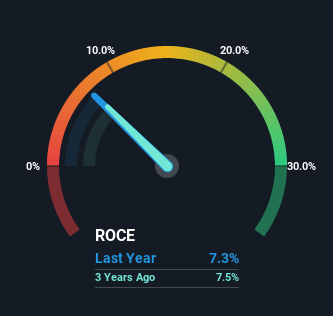- Hong Kong
- /
- Aerospace & Defense
- /
- SEHK:2357
The Returns At AviChina Industry & Technology (HKG:2357) Aren't Growing

If we want to find a potential multi-bagger, often there are underlying trends that can provide clues. Firstly, we'd want to identify a growing return on capital employed (ROCE) and then alongside that, an ever-increasing base of capital employed. Ultimately, this demonstrates that it's a business that is reinvesting profits at increasing rates of return. However, after investigating AviChina Industry & Technology (HKG:2357), we don't think it's current trends fit the mold of a multi-bagger.
Return On Capital Employed (ROCE): What Is It?
For those that aren't sure what ROCE is, it measures the amount of pre-tax profits a company can generate from the capital employed in its business. To calculate this metric for AviChina Industry & Technology, this is the formula:
Return on Capital Employed = Earnings Before Interest and Tax (EBIT) ÷ (Total Assets - Current Liabilities)
0.073 = CN¥4.8b ÷ (CN¥134b - CN¥70b) (Based on the trailing twelve months to June 2022).
Therefore, AviChina Industry & Technology has an ROCE of 7.3%. In absolute terms, that's a low return, but it's much better than the Aerospace & Defense industry average of 6.0%.
Check out the opportunities and risks within the XX Aerospace & Defense industry.

Above you can see how the current ROCE for AviChina Industry & Technology compares to its prior returns on capital, but there's only so much you can tell from the past. If you're interested, you can view the analysts predictions in our free report on analyst forecasts for the company.
So How Is AviChina Industry & Technology's ROCE Trending?
There are better returns on capital out there than what we're seeing at AviChina Industry & Technology. The company has consistently earned 7.3% for the last five years, and the capital employed within the business has risen 82% in that time. This poor ROCE doesn't inspire confidence right now, and with the increase in capital employed, it's evident that the business isn't deploying the funds into high return investments.
On a separate but related note, it's important to know that AviChina Industry & Technology has a current liabilities to total assets ratio of 52%, which we'd consider pretty high. This effectively means that suppliers (or short-term creditors) are funding a large portion of the business, so just be aware that this can introduce some elements of risk. Ideally we'd like to see this reduce as that would mean fewer obligations bearing risks.
Our Take On AviChina Industry & Technology's ROCE
As we've seen above, AviChina Industry & Technology's returns on capital haven't increased but it is reinvesting in the business. Since the stock has declined 17% over the last five years, investors may not be too optimistic on this trend improving either. On the whole, we aren't too inspired by the underlying trends and we think there may be better chances of finding a multi-bagger elsewhere.
AviChina Industry & Technology could be trading at an attractive price in other respects, so you might find our free intrinsic value estimation on our platform quite valuable.
While AviChina Industry & Technology may not currently earn the highest returns, we've compiled a list of companies that currently earn more than 25% return on equity. Check out this free list here.
New: Manage All Your Stock Portfolios in One Place
We've created the ultimate portfolio companion for stock investors, and it's free.
• Connect an unlimited number of Portfolios and see your total in one currency
• Be alerted to new Warning Signs or Risks via email or mobile
• Track the Fair Value of your stocks
Have feedback on this article? Concerned about the content? Get in touch with us directly. Alternatively, email editorial-team (at) simplywallst.com.
This article by Simply Wall St is general in nature. We provide commentary based on historical data and analyst forecasts only using an unbiased methodology and our articles are not intended to be financial advice. It does not constitute a recommendation to buy or sell any stock, and does not take account of your objectives, or your financial situation. We aim to bring you long-term focused analysis driven by fundamental data. Note that our analysis may not factor in the latest price-sensitive company announcements or qualitative material. Simply Wall St has no position in any stocks mentioned.
About SEHK:2357
AviChina Industry & Technology
Engages in the development, manufacture, and sale of civil aviation and defense products in Hong Kong and internationally.
Excellent balance sheet with moderate growth potential.
Market Insights
Community Narratives



